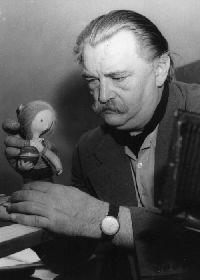 |
| This year is the 100th anniversary of his birth |
Ladislas Starevich or Jiří Barta.
Often considered to be the Disney of the East, this title has been seen as offensive by critics, as Trnka has nothing in common with Walt Disney, except for the fact that they both did animations. However, Trnka’s audience was formed of adults and his messages were more serious and sometimes even political, in a world where expression was often censored.
As a child, Trnka helped his mother and grandmother with sewing, but was also a self-taught wood carver and loved drawing. At 11, he was already working at the theatre and later he enrolled in the popular School of Applied Arts in Prague. After he graduated, he did various illustrations for newspapers and directed a few theatrical plays, but also had success as a painter. Some of the assistant animators that worked with him recall his extraordinary dexterity as he was able to paint with both hands at the same time, but also made puppets from scratch as a child.

He illustrated 130 books during his lifetime, and his puppets were very much like his illustrated art, unique figures with beautiful features. Although Trnka’s work was mostly around stories and legends, his last short film called The Hand (Ruka, 1965),was something completely different. It told the story of a happy potter artist who loved creating pots for his flowers until The Hand comes and requests hand statues. He is initially persuaded with money or fame, but ultimately when The Hand sees that the artist will not comply, it uses force. He ultimately dies from a heart attack and its funeral is celebrated by The Hand. In that era The Hand was nothing else but the state trying to censor an artist’s work. The same happened with Trnka and his art which was often limited by the state and even banned. Ironically, he was praised as a national artist when he died by the same state that had abused him and his art.
Trnka didn't like dialogue in his animation and often used the music of his friend, the Czech composer Vaclav Trojan as a way to help its characters express. It seems that sometimes he even changed some scenes so that they would fit the music of his friend.
There isn’t much information regarding Jiří Trnka life as he wasn't an outgoing artist and neither one that was obsessed with himself. He did art for his own pleasure and loved being immersed in the worlds he created, and perhaps that’s why he didn't care much about the outside world or writing an autobiography. His daughter remembers that when he worked only children were allowed in his studio and he always wanted to hear their criticism on his scenes. He loved what he was doing and he was a workaholic, sometimes working for a few days straight just to get a scene right.
The artist died in 1969, at a young age of 57 after a few years of isolation when he stopped making animations and returned to painting and illustrations. His early death was caused by the artist’s hectic lifestyle and also because he was a heavy smoker.
During his life he received international recognition and won numerous awards, despite the fact that he was working within a country that had a communist regime.
The last Trnka short film, The Hand:
You can buy his work here:
The Puppet Film Of Jiri Tranka / Story Of The Bass Cello / The Song Of The Prairie / The Merry Circus / A Drop Too Much / The Hand / Starring: Helena Patockova, Jaromir Sobotoa, Detsky pevecky sbor Jana Kuhna, Boris Karloff / Directors: Jirí Trnka, Milos Makovec
Further reading and sources:
http://www.radio.cz/en/section/czech-history/jiri-trnka-100th-anniversary-of-the-birth-of-a-great-czech-animator
http://notcoming.com/features/jiritrnka/
http://www.awn.com/mag/issue5.04/5.04pages/dutkatrnka.php3
http://www.michaelspornanimation.com/splog/?cat=38

